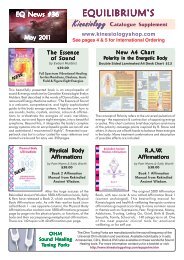You also want an ePaper? Increase the reach of your titles
YUMPU automatically turns print PDFs into web optimized ePapers that Google loves.
PE39 4,4’-DDE / 1,1-Dichloro-2,2-bis(4-chlorophenyl)ethene<br />
CAS 72-55-9<br />
A constituent of commercial DDT and a breakdown product of DDT. Due to its stability in fat, DDE is rarely<br />
excreted from the body, and body levels tend to increase throughout life. Substantial levels found in breast<br />
milk and in animal fat. An increased risk of testicular germ cell tumours. Has been linked to diabetes.<br />
DDT (This is not a vial in this kit but all the constituents of commercial DDT are.)<br />
Commercial DDT is banned in most countries but is a persistent pollutant in the environment. It is a mixture<br />
of several closely–related compounds. 4,4’-DDT (77%) and 2,4’-DDT (15%) are the main chemicals with<br />
Dichlorodiphenyldichloroethylene (DDE) and dichlorodiphenyldichloroethane (DDD) making up the balance.<br />
DDE and DDD are also the major metabolites and breakdown products in the environment. All four are in this<br />
kit.<br />
PE40 2,4’-DDT<br />
CAS 789-02-6<br />
Insecticide. Part of commercial DDT. Evidence of impaired fertility from animal studies. Banned in most countries<br />
but still found in fat tissue (both human and in animals/fish we eat) and breast milk.<br />
PE41 4,4’-DDT / 1,1,1-Trichloro-2,2-bis(4-chlorophenyl)ethane / 1,1-Bis(4-chlorophenyl)-<br />
2,2,2-trichloroethane<br />
CAS 50-29-3<br />
Insecticide. Part of commercial DDT. Evidence of impaired fertility from animal studies. Banned in most countries<br />
but still found in fat tissue (both human and in animals/fish we eat) and breast milk.<br />
PE42 Endrin 72-20-8 Insecticide; global ban taking affect mid 2012, but persistent in the<br />
environment. Endocrine disrupter and possibly carcinogenic.<br />
PE43 Glyphosate /Roundup<br />
CAS 1071-83-6<br />
Most used herbicide in USA. Used by public as well as in agriculture.<br />
PE44 Imazalil<br />
CAS 35554-44-0<br />
One of the most common residues found in food in the European Community.<br />
PE45 Imidacloprid<br />
CAS 138261-41-3<br />
One of the most widely used insecticides. Available in products for home use.<br />
PE46 Malathion<br />
CAS 121-75-5<br />
Insecticide; studies have shown that children with higher levels of malathion in their urine seem to be at an<br />
increased risk of attention deficit hyperactivity disorder.<br />
PE47 Metolachlor<br />
CAS 51218-45-2<br />
Evidence of it in ground and surface water. Concentrations have been found in fish.<br />
PE48 Parathion-Methyl<br />
CAS 298-00-0<br />
Insecticide. Used to control chewing and sucking insects in a wide range of crops, including cereals, fruit,<br />
vines, vegetables, ornamentals, cotton and field crops. Residues are regularly detected in a range of fruit<br />
and vegetables.<br />
PE49 Piperonyl Butoxide<br />
CAS 51-03-6<br />
Combined with other pesticides, products with piperonyl butoxide are often used to target mosquitoes, ants,<br />
worms, beetles, mites, flies, gnats, spiders, weevils, caterpillars, grubs, moths, ticks, lice, wasps, aphids,<br />
midges. U.S. Environmental Protection Agency (EPA) and the U.S. Department of Housing and Urban Development<br />
(HUD) collected samples (in 2009) with surface wipes from U.S. kitchen floors. Pipeonyl butoxide on<br />
52%.<br />
PE50 Trifluralin<br />
CAS 1582-09-8<br />
One of the most widely used herbicides used to control grass and weeds.<br />
Testing Kit Description Manual Copyright Jane Thurnell Read 2012 Page 141



